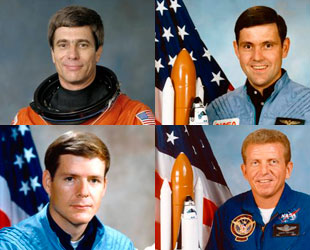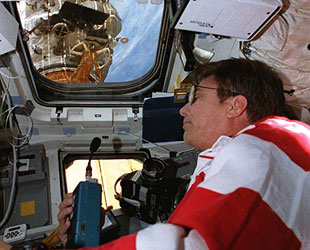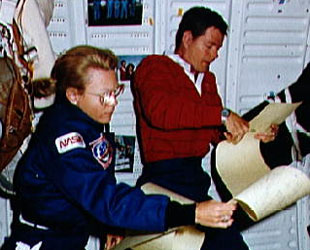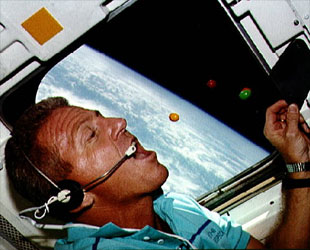|
|

|
Hall of Fame to induct Mir, Hubble, ISS and space shuttle astronauts

| The 2008 class of Astronaut Hall of Fame inductees: John Blaha, Robert Cabana, Bryan O'Connor and Loren Shriver |
January 9, 2008 — The commander of the mission that deployed the Hubble Space Telescope; an astronaut who once set a U.S. men's record for time in space; the first life sciences mission commander; and the astronaut who led the first assembly mission to the International Space Station, are all to be honored this May as the 2008 class of inductees into the U.S. Astronaut Hall of Fame.
The four space shuttle pilots: Loren Shriver, John Blaha, Bryan O'Connor and Robert Cabana were named today as the honorees by NASA's Kennedy Space Center Visitor Complex, which hosts the Hall in Florida. On May 3, the center will hold a ceremony in the 2008 class' honor with many of the 66 Mercury through shuttle-era veterans who were enshrined in the U.S. Astronaut Hall of Fame since its 1990 opening in attendance.
A committee comprised of the earlier inductees, current and retired space program workers, historians, authors, educators and journalists voted to select the enshrinees. Astronauts were eligible if they had made their first flight no later than 1991 and had been retired for at least five years from the astronaut corps. Candidates were required to be U.S. citizens who were trained by NASA as either commanders, pilots or mission specialists and had made at least one orbit around the Earth.
The Astronaut Scholarship Foundation, which will host a gala on May 2 celebrating the 2008 class, oversaw the selection of the voting committee and induction process. Though typically the classes are limited to two to three inductees, this year's voting came so close to merit the inclusion of a fourth honoree.
The committee chose the 2008 inductees based on their achievement during their spaceflights as well as how they contributed to the U.S. space program in other activities.
The 2008 class is the seventh group of shuttle astronauts to be named to the Hall since 2001.
John E. Blaha (Colonel, USAF, Ret.)

| Blaha aboard STS-79 as the shuttle is docked with his new home for the next four months, Russia's Mir Space Station. |
John Blaha became an astronaut in 1980 and over the span of 17 years flew on five space shuttle missions and one long-duration space station flight.
A U.S. Air Force Aviator and test pilot, Blaha first piloted Discovery on STS-29, the third flight following the loss of Challenger. His second flight was as pilot of STS-33, only the third shuttle mission to launch at night.
Blaha served as commander of his third and fourth trips to space. On-board STS-43, his crew deployed the West Tracking and Data Relay Satellite (TDRS) and operated experiments supporting the development of the extended duration orbiter and space station. STS-58 saw a record 14-day life science research mission that was recognized by NASA's management as the most successful flight of Spacelab that the space agency flew.
Blaha launched on his fifth and final mission on STS-79, which docked to the Russian Mir Space Station. The third American to live on the outpost, Blaha set the then-U.S. men's record for time in space during his four months on orbit.
Blaha also served on several NASA panels, including chairing the NASA Flight Safety Panel. He led the design, development and integration of the shuttle's heads-up display system and the abort procedures that significantly improved crew survivability in the event of multiple main engine failures during launch.
Blaha retired from NASA in 1997 to return to his home town of San Antonio, TX, where he joined the Executive Management Group of the United Services Automobile Organization.
Robert D. Cabana (Colonel, USMC, Ret.)

| Cabana floating onboard Endeavour near a window overlooking the first two docked modules of the International Space Station. |
Robert Cabana flew on four shuttle missions, including as commander of the first International Space Station (ISS) assembly mission.
Cabana piloted Discovery on his first flight, STS-41, five years after his selection as an astronaut. Discovery's crew deployed the Ulysses spacecraft, which is still in operation around the Sun. Cabana's second turn as pilot, STS-53, was on a Department of Defense mission.
He commanded STS-65, during which he and his crew set the then-record for the longest shuttle mission while conducting experiments inside the second International Microgravity Laboratory, a model flight for the science operations on the ISS.
Cabana's fourth and final flight was as commander of STS-88, the first ISS assembly mission. At the helm of Endeavour, Cabana and his crew carried the first U.S. built module, Unity, and mated it with the Russian's Zarya Control Module to form the basis of the station.Ê
Cabana was Deputy Chief of NASA's Aircraft Operations Division and Chief of the Astronaut Office. He served as Johnson Space Center's Deputy Director for three and a half years until October 2007, when he was reassigned to Stennis Space Center as its Director.
Bryan O'Connor (Colonel, USMC, Ret.)

| O'Connor (in red) reviewing procedures on STS-40 with mission specialist Rhea Seddon. |
Bryan O'Connor flew two missions prior to serving as the space agency's chief of safety.
O'Connor was pilot on STS-61B, the second night shuttle launch, deploying four satellites and testing the assembly of structures in space. He then commanded STS-40, the first shuttle mission dedicated to life science studies. His crew performed an vast series of biomedical experiments.
O'Connor left NASA in 1991 to become commanding officer of the Marine Aviation Detachment, Naval Air Test Center, but within a year returned to become the Deputy Associate Administrator for Space Flight. He led the redesign of the space station and was named acting space station program director and space shuttle director before departing NASA again to serve as a consultant.
In 2002, O'Connor again rejoined the space agency, this time as Associate Administrator, Office of Safety and Mission Assurance. In 2004, his title changed to Chief, Safety and Mission Assurance, reflecting his office's responsibility for the safety, reliability, maintainability and quality assurance of all NASA programs.
Loren J. Shriver (Colonel, USAF, Ret.)

| Shriver enjoys a snack of M&Ms on Atlantis' aft flight deck. |
Loren Shriver was selected as an astronaut with the first class of shuttle astronauts in 1978.
Shriver first flew as pilot of STS-51C, a classified mission for the Department of Defense. On his second flight, he led the deployment of the Hubble Space Telescope as commander of STS-31, beginning the telescope's nearly 20 years of imaging the universe.
Shriver's last spaceflight was on STS-46, deploying the European Retrievable Carrier satellite, a European Space Agency-sponsored free-flying science platform, and performing the first test of the Tethered Satellite System, a joint project between the Italian Space Agency (ASI) and NASA.
Prior to accepting his current position as Vice President of Engineering and Integration Chief Technology Office at United Space Alliance, he was the company's VP and Deputy Program Manager. Shriver was previously Deputy Director of the Kennedy Space Center from 1997 to 2000. |

© 2023 collectSPACE.com All rights reserved.
Questions? E-mail contact@collectspace.com

|
|

|

|
